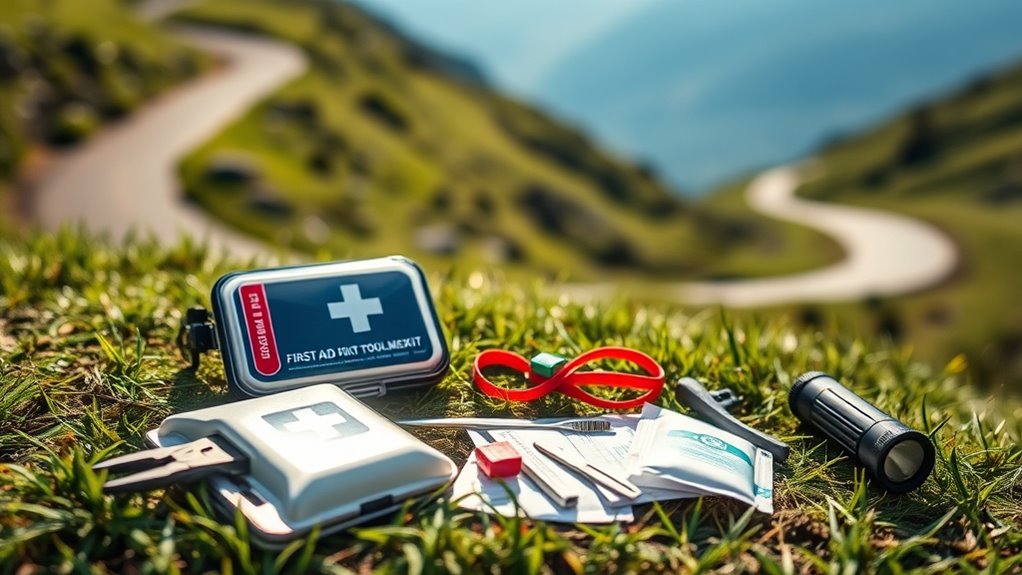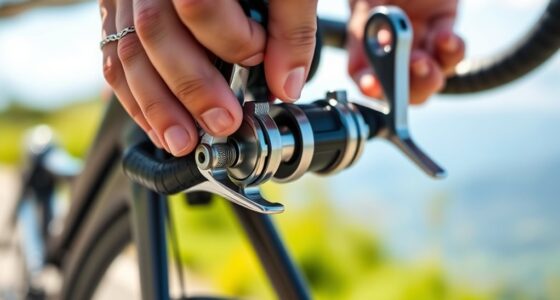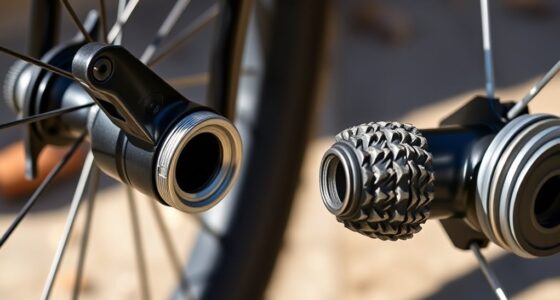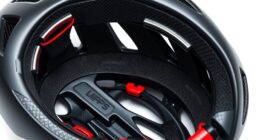To be prepared, carry a well-stocked first aid kit with essentials like bandages, antiseptic wipes, sterile gauze, scissors, gloves, a flashlight, and a whistle. Know how to handle common injuries such as cuts, scrapes, sprains, or head knocks by cleaning wounds, immobilizing limbs, or monitoring symptoms. Maintaining the kit and practicing basic first aid can save lives. Keep learning to guarantee you’re ready for any emergency on your cycling adventures.
Key Takeaways
- Carry a well-stocked first aid kit with bandages, antiseptic wipes, sterile gauze, scissors, gloves, and a flashlight for quick wound care.
- Include supplies for common injuries like cuts, scrapes, sprains, and fractures, and know how to apply them effectively.
- Use antiseptic to clean wounds immediately, then cover with sterile bandages to prevent infection.
- Carry tools like a bike chain repair kit and hydration supplies to address mechanical issues and dehydration on the spot.
- Know when to seek professional medical help for severe injuries such as head trauma, fractures, heavy bleeding, or signs of shock.
Essential First Aid Supplies for Cyclists
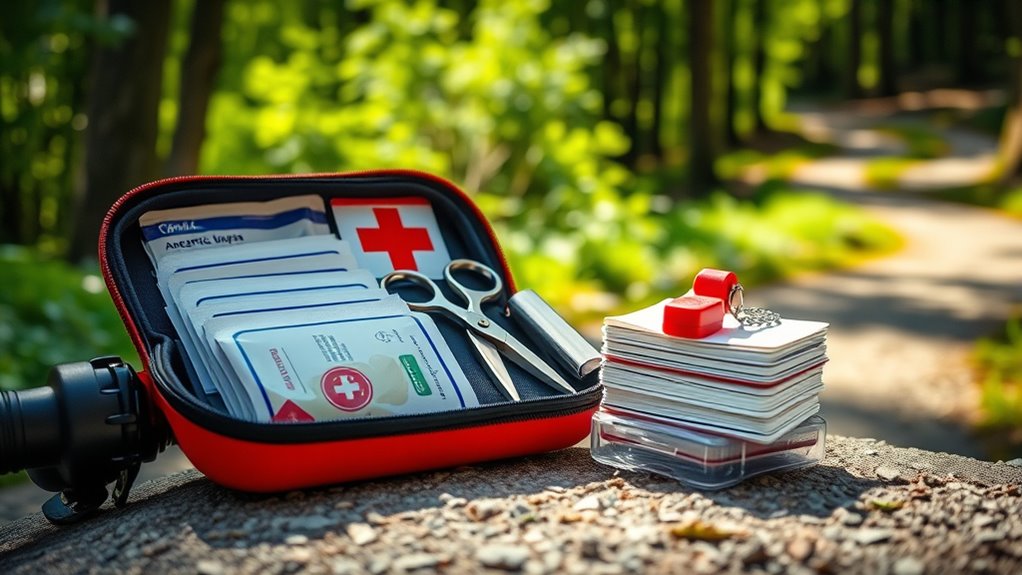
Having the right first aid supplies can make a crucial difference when you’re out cycling and an emergency occurs. Being prepared with essential items boosts your bike safety and guarantees you’re ready for unexpected injuries.
Carry a well-stocked first aid kit that includes bandages, antiseptic wipes, and adhesive tape to treat cuts and scrapes quickly. Bring sterile gauze and scissors for larger wounds, along with gloves to protect both you and others. Proper wound care techniques can prevent infections and promote faster healing. Additionally, knowing how to apply pressure to stop bleeding can be life-saving in critical situations.
A small flashlight can be invaluable in low-light situations, and a whistle helps summon help if needed. Having these supplies on hand demonstrates your commitment to emergency preparedness and keeps you ready for minor accidents or emergencies during your ride. Proper first aid procedures can also help you respond more effectively to injuries and potentially save lives.
In addition, familiarizing yourself with basic first aid techniques enhances your confidence in handling emergencies on the road. Proper gear can prevent minor injuries from worsening and help you stay safe on the road. Being aware of common cycling injuries and how to treat them ensures you’re better equipped to manage incidents promptly.
Recognizing Common Injuries and How to Address Them
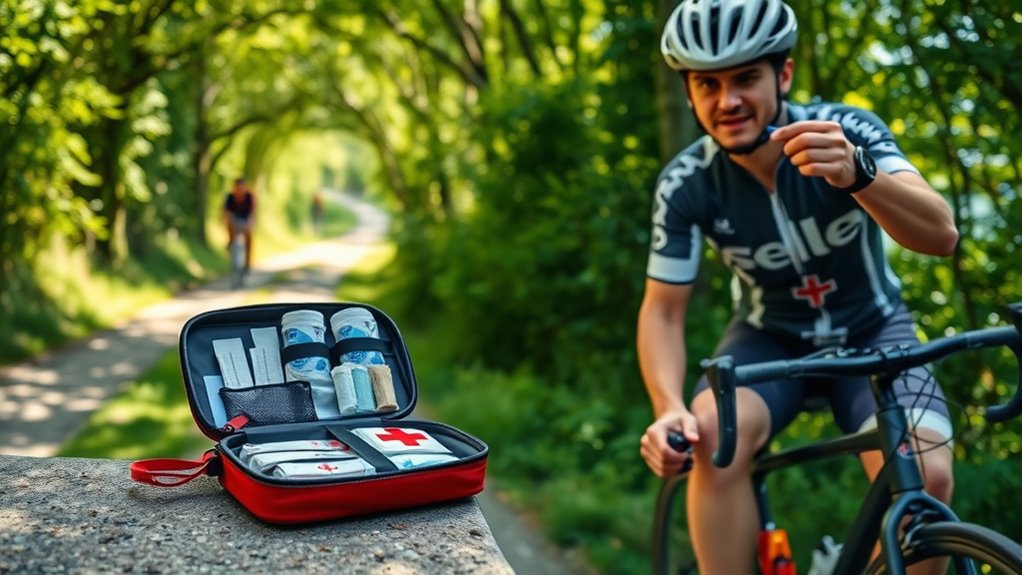
Recognizing common cycling injuries is essential for providing quick and effective first aid. By identifying issues early, you can prevent further harm and guarantee proper injury prevention. A basic understanding of how sound vibrations influence cellular health can also be valuable in promoting recovery and relaxation after an injury. Here are four injuries to watch for: 1. Cuts and scrapes – often from falls; clean and bandage immediately. 2. Sprains and strains – usually from awkward landings; rest and support the limb. 3. Fractures – look for swelling, deformity, or inability to move; stabilize and seek emergency communication. 4. Head injuries – signs include dizziness or confusion; monitor closely and call for help if needed. Being aware of first aid essentials ensures you are prepared to respond effectively in emergencies. Knowing these injuries helps you act fast, reducing severity. Always keep your first aid kit accessible and maintain clear emergency communication to summon help when necessary.
Applying Basic First Aid Techniques on the Spot

When you identify an injury on the spot, applying the correct first aid techniques can prevent it from worsening and promote faster recovery. If your chain breaks or jams, quickly perform a chain repair to get back on the road safely. For cuts or scrapes, clean the wound with water, apply antiseptic, and cover with a sterile bandage. If a cyclist shows signs of dehydration, offer water or electrolyte drinks and encourage rest in a shaded area. Keep the injured person calm and monitor their condition, especially if they’re feeling dizzy or weak. Remember, timely intervention can make a huge difference. Always carry basic supplies for chain repair and hydration management in your kit, so you’re prepared for common on-the-spot issues. Being aware of automation in business can help you understand how technology is evolving to support quick and efficient responses during emergencies, including the use of first aid technology and mobile apps that guide you through treatment steps. Additionally, using first aid kits with pre-stocked supplies can significantly improve response time and effectiveness in critical situations. Understanding the importance of portable medical devices can further enhance your ability to provide effective first aid in remote or outdoor settings. Incorporating emergency communication tools can also be vital for seeking help when necessary.
Tips for Assembling and Maintaining Your First Aid Kit
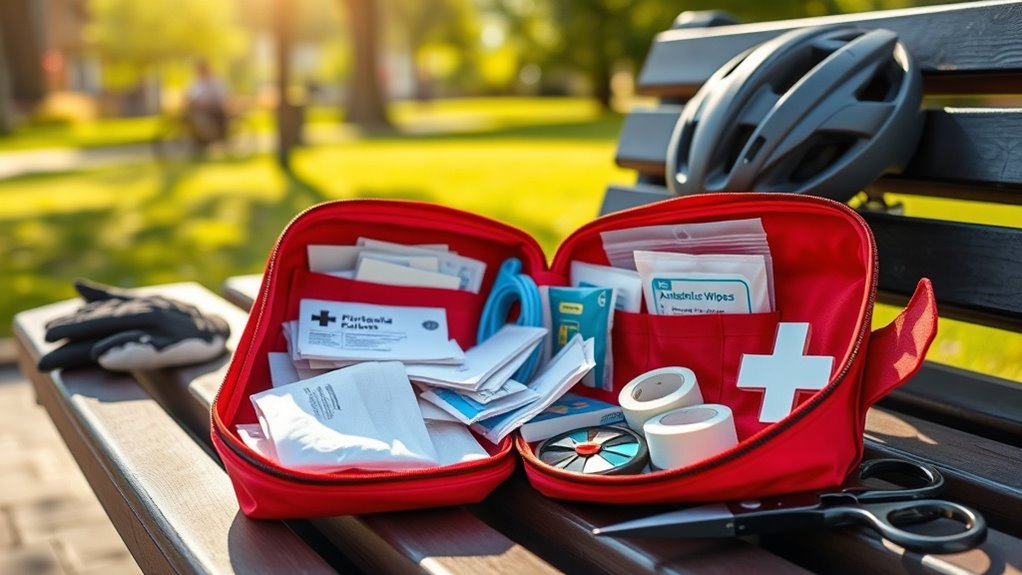
A well-assembled and maintained first aid kit is essential for quick and effective response to cycling injuries. To keep it ready, focus on proper kit organization so you can find supplies fast. Regularly review your kit with a maintenance checklist that includes: 1. Checking expiration dates on medications and ointments 2. Restocking used or missing supplies 3. Cleaning and disinfecting the kit container 4. Updating personal items like allergy medications or specific supplies. Keeping your kit organized prevents confusion during emergencies. Schedule routine inspections, perhaps monthly, to ensure everything is in top shape. Additionally, incorporating first aid training into your routine can improve your response effectiveness during emergencies.
When to Seek Professional Medical Help
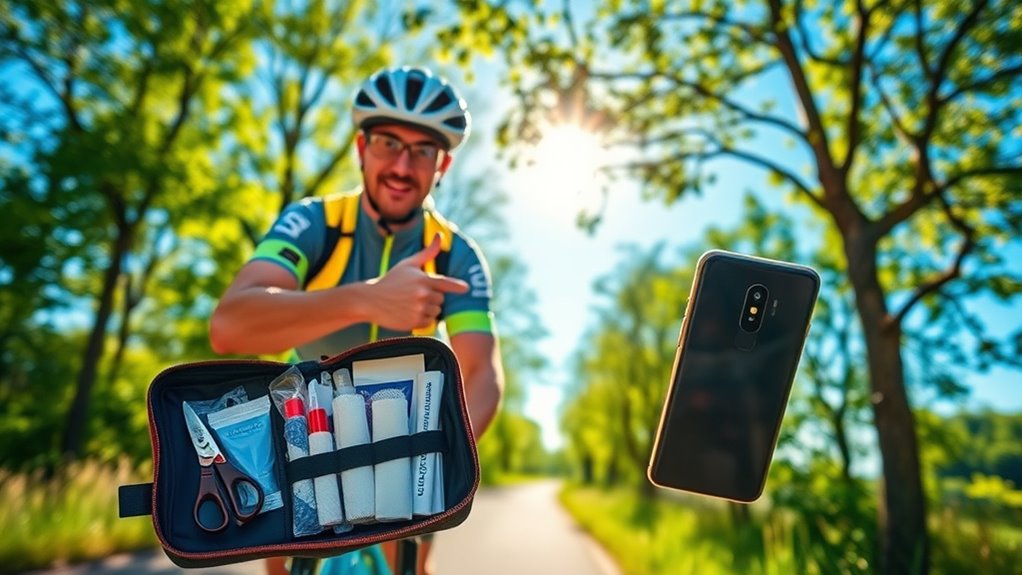
Knowing when to seek professional medical help can be critical after a cycling injury. If you experience severe bleeding, broken bones, head injuries, or signs of shock, you should immediately follow emergency contact procedures and call 911.
Don’t attempt to move someone with a suspected spinal injury unless absolutely necessary.
If the injury seems minor, monitor symptoms closely and seek medical attention if pain worsens or if symptoms such as dizziness, confusion, or difficulty breathing develop.
Trust your instincts—if something feels serious, it’s better to get checked out. Remember, timely intervention can prevent complications.
Additionally, understanding the importance of energetic alignment can help in assessing overall well-being after an incident, as emotional and energetic factors influence recovery.
When in doubt, it’s safest to call 911 and let emergency responders assess the situation. Your quick action could be life-saving.
Being aware of trauma management techniques can also aid in initial response and recovery.
Frequently Asked Questions
How Can I Prevent Injuries During Cycling Accidents?
To prevent injuries during cycling accidents, focus on helmet safety and always wear protective gear like knee and elbow pads.
Stay alert and ride within your skill level to avoid hazards. Keep an eye on the road, follow traffic rules, and use lights and reflectors for visibility.
Properly maintaining your bike also reduces the risk of accidents. These precautions help you stay safe and minimize injury risks during rides.
What Are Signs of a Serious Head Injury?
A gentle nudge from your helmet safety can indicate a more serious concern. Watch for signs of a serious head injury, like loss of consciousness, persistent headache, confusion, or vomiting.
If you notice concussion signs such as dizziness or blurred vision, seek medical help immediately. Always prioritize safety, and remember that even subtle symptoms can hide a bigger problem.
Protect your head, stay alert, and don’t ignore warning signs.
How Do I Deal With Bleeding Wounds Effectively?
When dealing with bleeding wounds, you need to act quickly and stay calm.
Start by applying direct pressure with a clean cloth or bandage to control bleeding.
Next, clean the wound gently with water to reduce infection risk.
Elevate the injured area if possible, and avoid removing embedded objects.
If bleeding persists, keep applying pressure and seek medical help immediately.
Proper bleeding control and wound cleaning are vital to prevent complications.
Are There Specific First Aid Items for Dealing With Fractures?
For fractures, you should carry items for fracture stabilization and splint application, like rigid splints or sturdy sticks, and padding materials.
When you spot a fracture, avoid moving the injured person unnecessarily.
Stabilize the limb by carefully applying the splint along the fracture, securing it with cloth or bandages.
Proper immobilization helps prevent further injury and reduces pain while waiting for emergency help.
How Can I Ensure My First Aid Kit Is Always Ready to Use?
You can guarantee your first aid kit is always ready by regularly checking its contents for expiration dates and replacing used or outdated items through first aid kit maintenance. Keep emergency contact updates current and accessible within the kit.
Store it in a designated, easily reachable spot, and perform monthly checks. This way, you’re prepared for any cycling mishap, ensuring quick and effective response when needed.
Conclusion
By carrying the right supplies and knowing simple first aid tricks, you’re like your own first responder on two wheels. Stay alert, act quickly, and keep your kit well-stocked — because accidents can happen when you least expect them. Think of your first aid kit as your trusty sidekick, ready to lend a helping hand. With confidence and preparation, you’ll navigate every ride safely, turning potential setbacks into stories of resilience.
